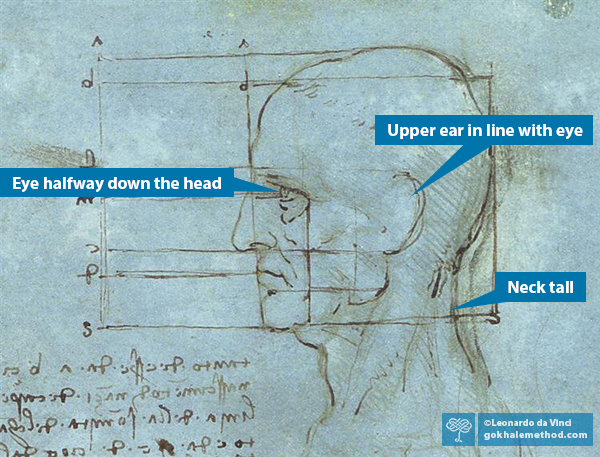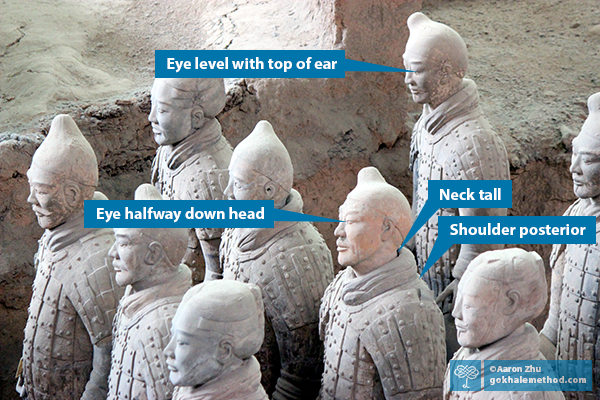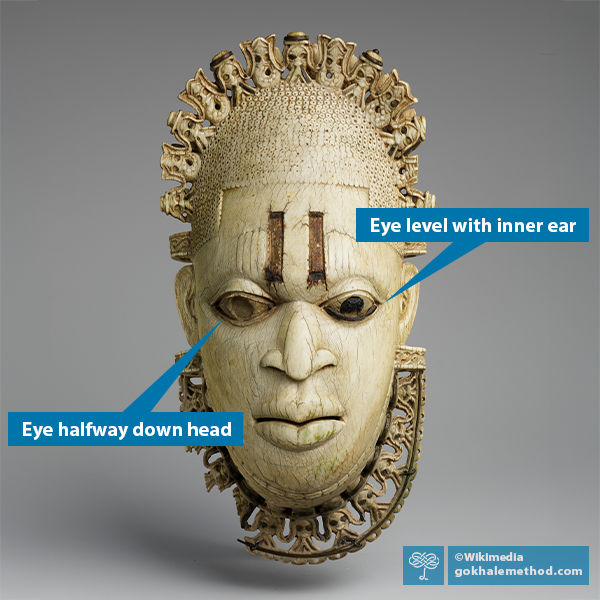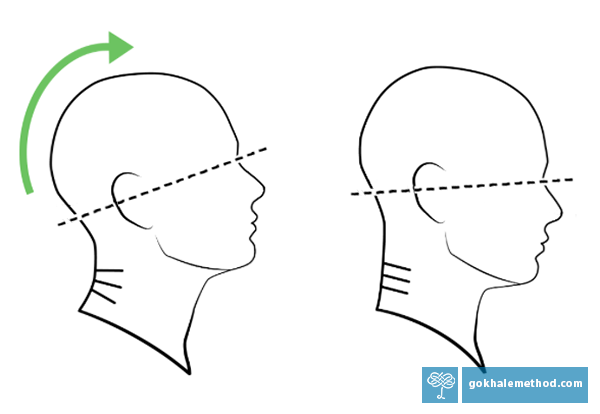Head Posture Lessons from Art and Sculpture
One of my favorite courses in college was called Italian Renaissance Sculpture and Art. Professor Sherman at Princeton opened my eyes to all sorts of beauty, innovation, and history. Of course, Leonardo da Vinci loomed large in the pantheon of great Italian artists and innovators. Leonardo melded art and science together in his quest to understand in detail the human body and its proportions. The principles he shed light on continue to be useful today, including in teaching healthy posture.
Leonardo’s well-known drawing about the placement of the eyes and facial features in relation to the skull is shown below. He noted that the eyes come halfway down the head.

Leonardo da Vinci examined and noted the proportions of the human body, head, and face, in mathematical detail.
Taking an art class
If you attend an art class in portraiture, you will likely use Leonardo’s now long-established guidelines. While there is some individual variation in the position and size of the nose, mouth, and ears, you will learn that the eyes are reliably halfway down the skull, in line with, or slightly above, the hole of the ear. This guideline works well when the head and neck are in a healthy, upright orientation, straight ahead of the viewer; if the back of the neck is contracted and/or the chin lifted, the eyes and ears are no longer on this line.
This video short gives a quick insight into how artists can establish proportions in their drawings.
The Terracotta Army
The use of naturalistic facial proportions is found in art across the globe. In China, the Terracotta Army is a vast array of clay sculptures depicting the armies of the first emperor, Qin Shi Huang. They were buried with the emperor in 210–209 BCE, with the purpose of protecting him in his afterlife. The figures were only rediscovered in 1974 by local farmers in Lintong County, Shaanxi, China. The warriors are wonderfully realistic—life-size, varying in height, as well as having individual facial features and slight differences in head tilt.

The ancient Chinese warriors of the Terracotta Army have the eyes halfway down the head, in line with the inner or upper ear. The highly accurate proportions of their heads are key to their naturalism.
The sculpture of Benin
The bronze and ivory artefacts of 16th century Benin, a historical kingdom of Nigeria, are renowned for their technical and aesthetic skill. The works include cast bronze panels, fully three-dimensional heads, and ivory masks. They vary widely in their treatment of the human form, some being highly stylized while others are more naturalistic, and yet the proportions of the heads are remarkably consistent.

The Queen Mother Pendant Mask, Iyoba, is highly ornamental in style, while using naturalism in placing the eyes level with the inner ears, halfway down the head. (16th century, ivory, Benin.)
The art of learning healthy posture
Gokhale Method® students are encouraged to use these visual cues to help rediscover the “tall neck” and “level head” positions that they would have enjoyed as infants. They learn to rotate their head and face down in combination with reestablishing healthy length and positioning of the neck. This natural posture avoids the cervical nerve compression and degenerative bone conditions people in our society commonly suffer. We teach a number of techniques to guide the head back home in our in-person Foundations course, one-day Pop-up course, our online Elements course, plus our Gokhale Active program.

The baseline of a level head position and a tall, spacious neck go together.
Try this technique
A good technique to start with is the “hair pull,” using your hair like a handle on your head to gently guide it up and back. You can watch our free “Hair Pull” video here. Like most Gokhale Method practice techniques, it takes just a moment to do. When you start learning this maneuver, it is best to check it in the mirror, and so it integrates easily as part of your morning or evening routine. You want to see your eyes level with your inner or upper ear, and the end of your nose level with your earlobes. You’ve got the picture!
Best next action steps
If you would like help taking your head and neck home to a healthier position, get started by booking a consultation, online or in person, with one of our teachers.
You can sign up below to join any one of our upcoming FREE Online Workshops…

Comments
Add New Comment
Login to add commment
Login